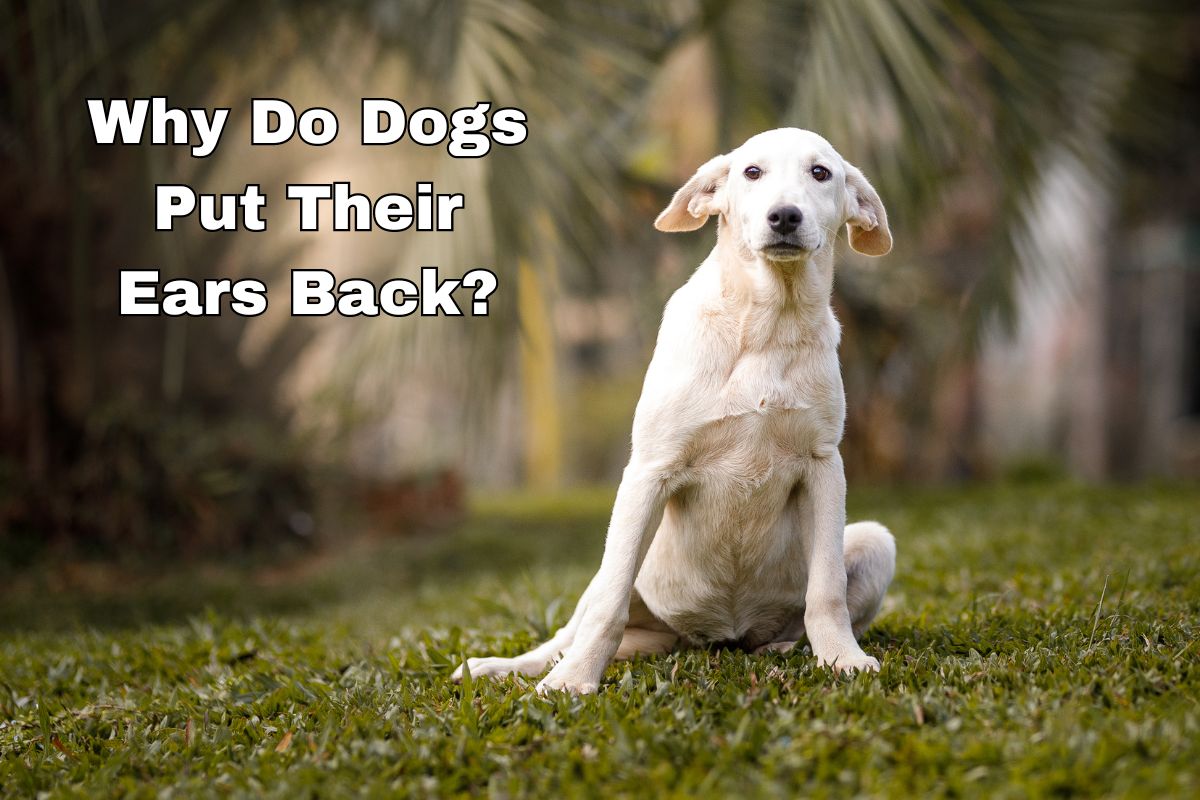Have you seen your dog with their ears pinned back on their heads? You know when your dog has their ears all the way back. What can that mean?
What are they telling us with this particular body language? Are they mad or are they sad? What does it mean when dogs put their ears back? Let’s find out!

Why Do Dogs Put Their Ears Back?
In “Tail Talk: Understanding the Secret Language of Dogs” by Sophie Collins, we see that dogs use their ears as a means of communication. Their ear positions can convey a lot about their emotional state. Dogs tell us so much with their body language.
It is so important to remember that interpreting a dog’s body language requires considering the context and the overall behavior, not just a single sign.
Additionally, each dog is unique, so these general reasons for ears being back can provide insight. It is essential to understand the specific dog’s personality and tendencies to accurately interpret their behavior.
Pinned back ears should be taken in conjunction with other cues like body posture, tail position, facial expression, and vocalizations to accurately gauge the dog’s emotional state.
If you encounter a dog with pinned-back ears, it is best to approach cautiously and respectfully to avoid further stressing or startling the dog.
Top 6 Reasons Why Dogs Put Their Ears Back
Let’s cover the main reasons why your dog may have their sweet little ears back. The reasons range from submissiveness to aggression. It is a fine line to try to decipher what is going on.
This list is not clear cut. You have to know the dog to really understand what that particular dog is trying to communicate. If you don’t know the dog then be sure to try to read the signs that the dog is trying to communicate to you.
1. Fear
One of the most common reasons for a dog to hold its ears back is fear (or anxiety). When a dog is feeling threatened, scared, or uncomfortable, they might flatten their ears against their head as a way to make themselves appear smaller and less noticeable.
This behavior is often accompanied by other signs of stress such as trembling, avoiding eye contact, or cowering. This body language is showing you that the dog is feeling overwhelmed and frightened. So read the cues and act accordingly…give them space.
If the dog is tense, that is a huge indicator that something is going on. You can tell if a dog is relaxed or on edge. You have to check to see what is happening.
Fear can lead to lashing out and aggression. Dogs can only share what their are feeling in a few different ways. Therefore you have to give them the ability to communicate what they are feeling in a safe manner.

2. Submissiveness
Dogs might also pull their ears back when they’re trying to show submission to a more dominant individual. The dog could be putting their ears back to show they are accepting the other dog, animal, or person. This can happen in play or in another setting.
When a dog is relaxed and comfortable, their ears are usually in a neutral or a natural position, facing forward or slightly to the sides. However, if a dog’s ears are pinned back against their head, it often suggests that the dog is trying to make themselves appear smaller and less threatening.
When you are upset with your dog when they do something naughty they may be presenting their ears back. They are submitting, and perhaps that they are feeling a little guilty. They are presenting themselves as non-threatening.
3. Aggression
Of all of the reasons why a dog will have their ears back, this is the most important one to watch out for. In some cases, a dog might pull its ears back as a sign of aggression or even agitation.
Pinned-back ears can be a response to feeling threatened or challenged. Aggressive posturing might be accompanied by growling, barking, and other signs of hostility. This is what happens before they feel like they have to escalate the situation.
According to “Dog Bite Prevention: Dogs Bite When Humans Greet Inappropriately” by Dr. Sophia Yin, DVM, MS “Over 4.5 million people are bitten by dogs every year and about 800,000 of those bites are severe enough to warrant a trip to the hospital.” You don’t want to add to that number.
Pinned back with teeth, barking, growling, facial expressions, and stiffness are all signs that need to be accounted for. This combined with signals of being fearful and nervous. It could mean a dog is ready to attack.
Give the dog space if you see these behaviors. You want to keep the dog and (yourself) safe. Dogs can not speak to us so we have to interpret what we are seeing and guess what they are communicating.
Check out the video below by dog training expert Zak George for tips on stopping dog aggression.
4. Discomfort
Flattened ears can be a sign of pain in dogs. The dogs could have ear-related issues, headaches, or other physical ailments that could make them put their ears back. They could be trying to protect their ears.
It is important to note if you think there may be a medical reason for your dog’s behavior you should contact your veterinarian. If you are ever worried about this (or any other behavior that your dog exhibits) please reach out to a professional. A veterinarian is a professional and can help you with any of your questions about your furry friend.
If your dog’s ears are back because they are itchy then check out “Itchy Ears in Dogs – Natural Approaches to Easing the Itch.” There are some great tips on how to address itchy ears. See if it helps your dog!
5. Alertness
While this reason may not be as common, some dogs might pull their ears back as a sign of intense focus or alertness. They might be trying to tune in to specific sounds in their environment. It is similar to when you have to turn down the radio when you are driving because you need to concentrate.
Ears back and nose in the air, that dog is trying to figure things out. They are using their tools to understand what is happening around them. They are listening and hyperfocused.
Sometimes dogs have their ears back so they can hear things behind them. It depends on the breed and how their ears are pointy, or droopy, if they are big or little. The ears are a huge way on how dogs experience the world.
A dog’s ears can go up trying to hear something or they may have their ears pushed back. Dogs want to figure out their surroundings. They just do it in different ways.
6. Playfulness
Some dogs put their ears back when they are being playful. For example, this author’s Yorkie/Chihuahua mix puts her ears back, crouches down, and has her back end in the air. That is her signal that she is ready to engage in some play.
This ear position can also be a sign that they are happy and therefore ready to have some fun. So this position doesn’t have to mean something negative. It definitely can be something happy.
A happy dog is relaxed and friendly. Some of the other body language presentations help you decipher what their intent may be. What are the signs your dog is sharing with you?
For example, when a dog is being playful their tails may be wagging, perhaps a playful bark, or sweet and squinting eyes. You can see the joy. The ears are a part of the story, you have to find out all the parts of the story.
For more interesting things your dog’s ears are telling you, check out the video below:
Conclusion
Dogs’ body language can be complex, and sometimes, their ears might be pulled back as a combination of different emotions. For instance, a dog might be excited and happy to see someone but also a little nervous. This can lead to a mix of signals including ears being back but tail wagging.
Since we covered ears, here are some ways to protect your dog’s precious ears. Check out “Dog Care Hacks for Protecting Fido’s Eyes and Ears.” Pinned dog ears or alert ears all need some love.
Remember that not all dogs can put their ears back. Some breeds have anatomies that do not physically allow them to lay their ears in various positions. Because of that you need to be mindful of different signs they may be sending you.
As we know that the ear position is one part of how dogs tell us things. So we have the duty to try to put the entire story together. This is a relationship and we have to do the work to make sure we are doing our part.
Hopefully this has shown you ways that you can help stop miscommunication with your pooch. Because when we get it wrong it does no one any good. We want to support our dogs and do the best for them.
Were there some things you learned about ears? What does your dog do with their ears? We would love to hear (pun not intended) more from you!


